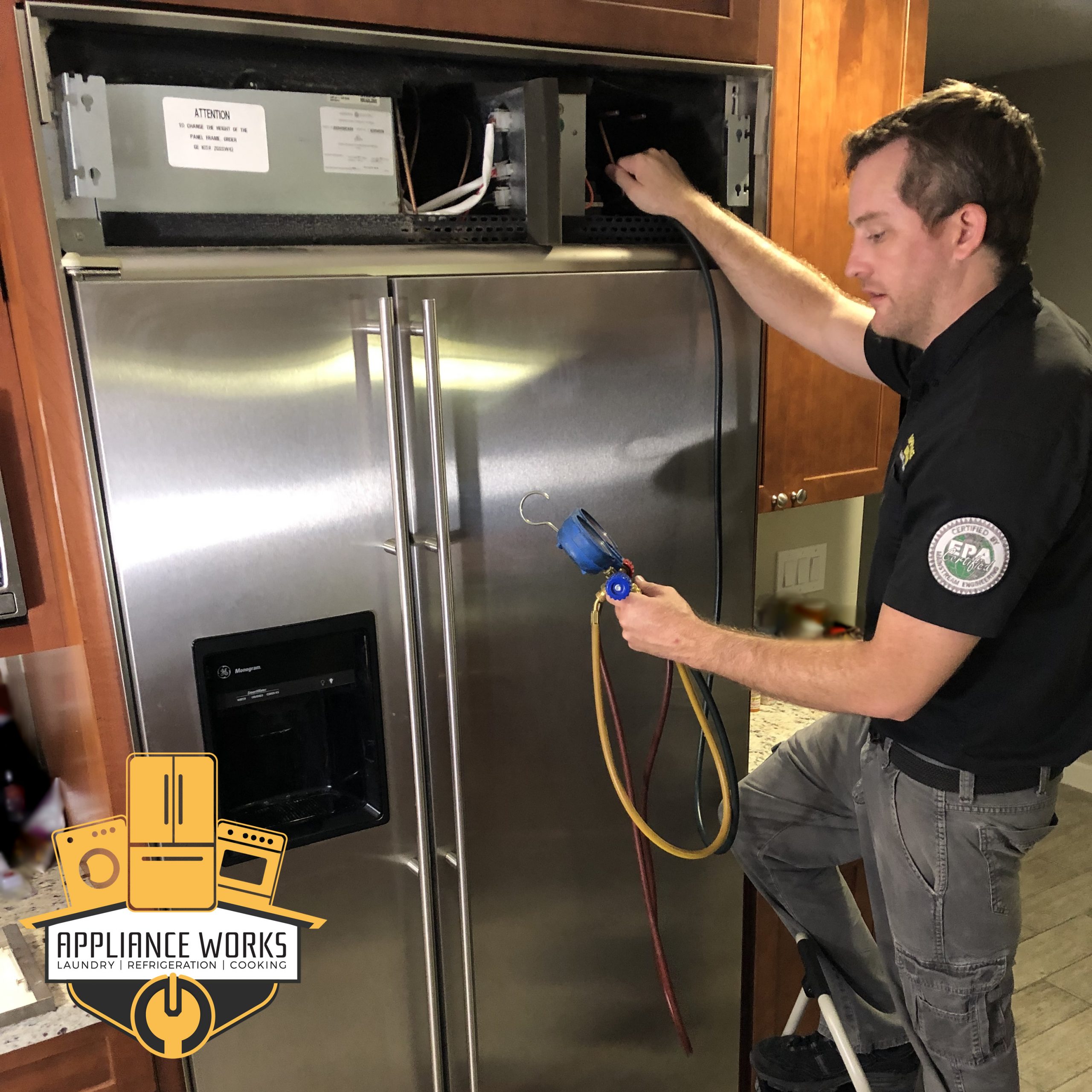The Ultimate Overview to DIY Appliance Repair Work Techniques
From refrigerators to dishwashers, understanding just how to troubleshoot and fix these gadgets can save you time and cash. Are you ready to find crucial strategies that will encourage you to handle repairs with confidence?
Comprehending Usual Device Troubles
When you count on your home appliances, it can be frustrating when they suddenly quit working or act up. Understanding usual home appliance problems can aid you repair problems efficiently.
If your oven isn't heating, malfunctioning elements or thermostat issues can be to criticize,. Dish washers often experience troubles with drainage, so ensure the filter is clean and the drainpipe hose pipe isn't kinked.
Likewise, pay attention for uncommon noises; they often show mechanical issues. By identifying these indications, you can conserve time and potentially stay clear of costly fixings. A little understanding goes a lengthy method in maintaining your home appliances, so remain informed to keep every little thing running smoothly.
Important Devices for DIY Repair Works
Prior to diving right into DIY home appliance repairs, it's crucial to collect the right tools to ensure the procedure goes efficiently. Start with an excellent collection of screwdrivers, consisting of both flathead and Phillips, as they're important for opening most devices. You'll also want a pair of pliers for clutching and twisting cables or small elements.
Do not neglect a multimeter; it aids you examination electric parts and diagnose issues successfully. An outlet collection comes in handy for loosening up or tightening up screws, while an energy blade can be valuable for opening or cutting wires packaging.
Lastly, think about having a flashlight accessible to illuminate dark spaces inside your devices. With these vital devices, you'll be well-equipped to deal with different repair services, conserving both time and cash. So, collect your equipment and prepare yourself to roll up your sleeves!
Safety First: Precautions to Take
Before you begin any kind of device fixing, it's necessary to prioritize safety and security. Make sure you put on individual protective equipment, disconnect the source of power, and maintain your work location arranged. These straightforward preventative measures can assist avoid accidents and assure a smoother fixing process.

Personal Protective Devices
Safety and security gear is a crucial part of any type of DIY home appliance repair service job. You need to constantly put on security goggles to secure your eyes from dirt and debris. A strong pair of gloves will certainly protect your hands from sharp sides and hazardous products. Think about using a mask if you're dealing with chemicals or dust, ensuring you take a breath securely while functioning. Steel-toed boots are likewise a wise choice, especially when raising hefty home appliances. Don't forget to put on lengthy sleeves and pants to safeguard your skin from potential injuries. By focusing on individual protective equipment, you'll substantially lower the danger of mishaps and injuries. Bear in mind, being prepared with the ideal gear maintains you secure and concentrated on completing your fixing effectively.
Source Of Power Disconnection
To assure a safe DIY home appliance repair, separating the power source is crucial. Before you begin any job, you should unplug the device or turn off the breaker. This easy action prevents electric shocks and warranties that you can concentrate on the repair service without fretting about unintended activation. Always confirm that the device is off by testing it with a voltage tester. If you're taking care of bigger devices, like a washer or dryer, see to it to secure the power cord and prevent any kind of call with water. Remember, security initially! Once you're positive that the power is detached, you can with confidence continue with your repairs, understanding you've taken the needed preventative measures to safeguard on your own.
Work Area Organization
An efficient workspace can make all the distinction in your do it yourself device fixing job. Begin by clearing your workspace of mess to avoid crashes and disturbances. Lay out all your tools and products, organizing comparable items with each other for very easy gain access to. Use a tool kit or coordinator to keep small components like screws and washers had and classified. Ensure you've obtained sufficient lights; it'll help you see information clearly and reduce the threat of errors. Do not fail to remember to keep safety and security gear like handwear covers and safety glasses within reach. Have a trash bag convenient to dispose of waste immediately. A tidy room not only boosts effectiveness but additionally keeps you secure while you deal with your appliance fixing.
Step-by-Step Guide for Fridge Services
When your refrigerator begins breaking down, it can be irritating, however taking on the trouble yourself can conserve you time and money. Disconnect the refrigerator to assure safety. Look for typical problems like temperature level variations or unusual noises. Inspect the thermostat settings; they might be set too high if it's not cooling. Next, clean the condenser coils, which commonly accumulate dirt and particles. For a loud refrigerator, examine the follower and validate it's not blocked.
If there's water pooling within, evaluate the door seals for damages or dirt, and tidy them if essential. As soon as you've addressed the issue, connect the refrigerator back in and monitor it for a few hours.
Repairing Washing Equipment Concerns
Much like refrigerators, washing equipments can offer their very own set of obstacles, yet many concerns can be settled with a little bit of troubleshooting. Initially, if your device will not start, check the power cord and verify it's connected in. Next off, evaluate the door latch; a malfunctioning lock can protect against the cycle from starting. It might be due to read foreign objects stuck in the drum or the drain pump. if you discover unusual noises during operation.
If your garments aren't obtaining tidy, take into consideration the water degree and cleaning agent kind; utilizing excessive detergent can create excess suds, affecting efficiency. For leakages, check out the pipes for fractures or loose connections. Tightening these can often solve the trouble. Routine maintenance, like cleaning the filter, can prevent several concerns from developing. Keep in mind, a little troubleshooting goes a long means in maintaining your washing machine running efficiently.
Fixing Ovens and Stoves
Just how can you troubleshoot common problems with your oven or oven? Start by checking the power supply.
If your oven isn't home heating, check the temperature setups and validate the door seals snugly. If it's harmed., a defective home heating element might additionally be the culprit; you may require to replace it.
For unequal food preparation, rotate your frying pans and consider utilizing a stove thermometer to verify precise temperatures. If you listen to unusual sounds or scent gas, turn off the home appliance quickly and speak with a specialist. By following these actions, you can identify and fix several typical stove and stove issues effectively.
Fixing Dish Washers Made Easy
When your dishwashing machine begins breaking down, it can be aggravating, however resolving common problems isn't as difficult as it appears. You'll discover detailed troubleshooting approaches that will certainly help you pinpoint the problem, together with the crucial devices you'll require to deal with repair services on your own. Let's make fixing your dishwashing machine a wind!
Typical Dishwashing Machine Problems
While dish washers are made to make your life less complicated, they can occasionally encounter common issues that leave you feeling frustrated. One constant trouble is inadequate cleansing efficiency; this commonly happens due to blocked spray arms or filthy filters. You may likewise observe water merging near the bottom, which can indicate a defective drain or a kinked hose. If your dish washer's door will not lock, maybe a basic concern with the lock mechanism or door seal. Additionally, unusual sounds can indicate loose components or damaged components. Lastly, if you scent something weird, it could be time to inspect for food debris or a malfunctioning electric motor. Dealing with these concerns early can save you time and hassle later on (Best Sub-Zero repair Service Dependable Refrigeration & Appliance Repair Service).

Step-by-Step Troubleshooting
Prior to diving into repairs, it's important to recognize the particular problem your dish washer is dealing with. Beginning by checking if it's unclean properly. Check the spray arms for obstructions and assurance they rotate openly. If it's leaking, check out door seals and hoses for like this any type of damages. For unusual noises, pay attention very closely during cycles; international things may be stuck in the filter or impeller. If your dishwashing machine will not begin, examine the power supply and door latch. Do not neglect to consult your user manual for fixing tips details to your design. By systematically resolving each possible issue, you can pinpoint the problem and take the essential steps to repair it, making your dishwashing machine feature like brand-new once more.
Vital Repair Service Tools
Having the right devices at your disposal can make all the difference when fixing your dishwashing machine. Don't neglect a container or towels for any water splashes during fixings.
You could also want a degree to assure your dishwasher's appropriately straightened. With these important devices, you'll be well-appointed to tackle any type of dish washer repair difficulty that comes your method.
Regularly Asked Questions
Exactly how Do I Figure out if a Device Is Worth Repairing?
To figure out if a device's worth fixing, consider its age, fixing costs, and current value. You may desire to spend in a brand-new design rather - Authorized Subzero Repair Tucson Dependable Refrigeration & Appliance Repair Service. if repairs exceed half the substitute price.
Can I Discover Replacement Parts Locally for My Device?
Yes, you can usually discover substitute parts locally for your device. Inspect hardware shops, device service center, or regional classifieds. Do not fail to remember to bring the model number to ensure you get the right part!
When Fixing Devices?, what Typical Mistakes Should I Prevent.
When fixing home appliances, avoid hurrying with diagnostics, ignoring safety and security preventative measures, or using wrong tools. Do not avoid reviewing handbooks or watching tutorials; they give necessary assistance. Hold your horses and complete to guarantee effective repair work and protect against additional damages.
How much time Does a Common Do It Yourself Appliance Fixing Take?
A common do it yourself appliance repair service usually takes one to three hours, relying on the complexity. You'll intend to collect your whirlpool cabrio dryer belt replacement products and tools first, and adhere to instructions very carefully to avoid unnecessary hold-ups.
Exist Any Guarantees for Do It Yourself Device Repair Works?
When you deal with do it yourself appliance repair work, service warranties typically don't cover your job. Nonetheless, some manufacturers could honor service warranties for components you change. Always check your home appliance's guarantee terms prior to beginning any kind of repairs to avoid issues.
Before diving right into Do it yourself device fixings, it's vital to gather the right devices to guarantee the process goes smoothly.Before you start any appliance repair, it's important to prioritize security.To ensure a risk-free DIY appliance repair work, disconnecting the power source is important.A well-organized work location can make all the distinction in your Do it yourself home appliance repair service job. Always check your appliance's warranty terms prior to beginning any type of repair services to prevent issues.